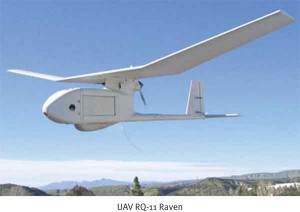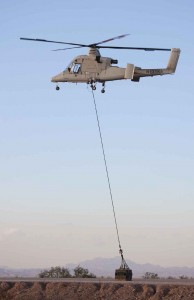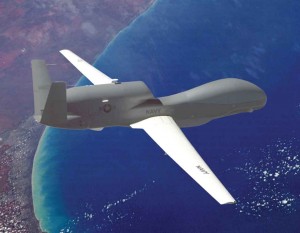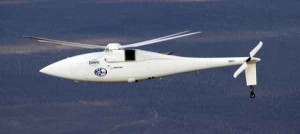The term Unmanned Aerial Vehicle (UAV) is being slowly replaced by UAS as in many of its variegated missions, the aircraft is not carrying any payload from one place to another and is thus not a vehicle. Similarly, the term Remotely Piloted Vehicle is also being rendered inaccurate on account of the autonomy modern UAS craft exercise once launched. Technically speaking, UAS existed before manned, heavier-than-air flight. During the American Civil War, both the contending forces launched unmanned balloons loaded with explosives, but with limited and unremarkable success. The advent of the first powered flight led to substantial advances in technology related to fixed and rotary wing aircraft. However, unmanned flight took some time to catch the fancy of the inventor.
On December 17, 2011, a K-MAX unmanned helicopter of US Marine UAS Squadron 1 carried out the first ever resupply mission in a combat zone, carrying food and supplies to a forward operating base in Afghanistan. The mission was critical by way of air maintenance and as successful as if a pilot had been onboard. The difference was that although it was flown under extremely hostile conditions, no human was at risk during the mission. Since then, the two K-MAX deployed there have carried out six missions per day, some of them with a single under-slung load of over 1,900kg. This is just one illustration of the spectacular developments in the field of Unmanned Aerial Systems (UAS) that have taken place in recent years.
Unmanned aviation is a domain which has exploited variegated technologies to its advantage.
The term Unmanned Aerial Vehicle (UAV) is being slowly replaced by UAS as in many of its variegated missions, the aircraft is not carrying any payload from one place to another and is thus not a vehicle. Similarly, the term Remotely Piloted Vehicle is also being rendered inaccurate on account of the autonomy modern UAS craft exercise once launched. Technically speaking, UAS existed before manned, heavier-than-air flight. During the American Civil War, both the contending forces launched unmanned balloons loaded with explosives, but with limited and unremarkable success. The advent of the first powered flight led to substantial advances in technology related to fixed and rotary wing aircraft. However, unmanned flight took some time to catch the fancy of the inventor.
Although conquering air through ever increasing measures of velocity, manoeuvrability and agility did produce deadly and destructive flying machines, matching advances in digital communication technologies providing for remote control through electronic means and artificial intelligence permitting high degrees of autonomous control, were slow in coming. While there were some attempts to develop unmanned aerial craft during the 1930s, notably by the US Navy, serious advances in this field took shape just before World War II with US and UK producing and refining radio-controlled, pilotless aircraft for use as targets for the training of anti-aircraft gunners. The first successful aircraft of this genre was the British ‘Queen Bee’. Aviation history honours it till today inasmuch as unmanned aircraft are called “drones”.
 Unmanned aviation is a domain which has exploited variegated technologies to its advantage. On the one hand, nano technologies have been harnessed to produce a small UAS like the Raven which is only slighter bigger than its ornithological namesake and weighs less than two kilogram. In contrast stands the Global Hawk that tips the scales at 11.6 tonnes and flies at 400 knots for over 30 hours at 65,000 feet.
Unmanned aviation is a domain which has exploited variegated technologies to its advantage. On the one hand, nano technologies have been harnessed to produce a small UAS like the Raven which is only slighter bigger than its ornithological namesake and weighs less than two kilogram. In contrast stands the Global Hawk that tips the scales at 11.6 tonnes and flies at 400 knots for over 30 hours at 65,000 feet.
Saving Lives in the Battlefield
The first rotary wing aircraft lagged behind the first fixed wing flight by about four years. However, the development of the helicopter as a military platform lagged far behind. The early traditional role that the military assigned to the helicopter was evacuation of the wounded from the battlefield. That is a role rotary wing aircraft will perform forever. It is also the role where the risk to the helicopter pilot is the maximum, with enemy ground fire and unprepared landing area rendering the conditions truly hostile. A combined team from Carnegie Mellon University (CMU) Robotics Lab and Piasecki Aircraft Corporation (PAC) has successfully flown a full-size helicopter past low-level obstacles to safe touchdowns completely autonomously.
The development of the helicopter as a military platform lagged far behind…
The helicopter was able to pick out and autonomously avoid obstacles such as chain-link fencing, pallets only four inches high, an extended man lift, power lines and people on the ground to navigate to safe landing sites. This astounding level of autonomy is enabled by a software system that uses GPS, inertial navigation, and Light Detection and Ranging (LIDAR) to generate a 3D point cloud of the terrain below and ahead of the helicopter in real time as it flies along. From there, the system creates a plan to follow the best route to its objective on reaching which, the system verifies that a suitable ground route exists from that location to a good landing site. The system thus allows a helicopter to negotiate obstacles such as trees and high-tension power lines and pick its own landing sites without human assistance. The enormous advantage it offers is self-evident. Lives of combatants in the battlefield can be saved without endangering the lives of pilots.
Logistic Support
Technology permitting, such levels of autonomy would also be useable for helicopters carrying out re-supply in the battlefield which could thus be achieved with pin-point accuracy without risk to any pilot’s life. The K-MAX re-supply helicopter mentioned earlier is produced by Lockheed Martin Corporation and Kaman Aerospace Corporation who had teamed up in 2007 to transform the Kaman’s manned power-lift helicopter in use since 1990s, into a UAS capable of autonomous or remote-controlled cargo delivery. The craft’s onboard computer uploads the mission plans, enabling flight on auto-pilot. However, an operator at a mission base control monitors progress and can step in and override the autopilot for manual operation should problems occur, or if the UAS needs to be re-directed in mid-flight.
The US Marine Corps has also successfully tried out a procedure known as a ‘hot hook-up’ using an unmanned Kaman K-Max at Camp Dwyer in Afghanistan. This is done by the K-MAX hovering and deploying a long sling, which Marines on the ground then load with cargo. The onboard computer factors in wind speed to reduce ‘the hook swing’ and makes it safer for Marines to attach the cargo. The K-MAX itself weighs just 2.5 tonnes, but can carry 3.5 tonnes of cargo over 250 miles.
The use of rotary wing UAS for this role not only permits re-supply without risking the lives of pilots, but also reduces the number of road transport convoys to forward operating bases, which in Afghanistan are vulnerable to roadside mine activity and bomb attacks. The convoys themselves need protection. Thus every flight means the reduction of risk to road convoys and precious human lives.
Another rotary wing UAS is the A160T Hummingbird produced by Boeing. A Defence Advanced Research Projects Agency (DARPA) contract project, the Hummingbird has a unique carbon-fibre rotor blade which gives it far better range and endurance than other helicopters or UAS. The Hummingbird holds the record for flight endurance, an 18.7-hour flight without refuelling. Its ceiling of 30,000 feet is around 10,000 feet higher than that of conventional helicopters. Astoundingly, it can hover at 15,000 feet. Built in 1999, in response to request from DARPA, the 35-foot long UAS carries surveillance equipment, a high resolution colour video camera that can track people and vehicles from altitudes above 20,000 feet across 168 square kilometres.
The early traditional role that the military assigned to the helicopter was evacuation of the wounded from the battlefield…
The surveillance capability onboard, dubbed Autonomous Real-time Ground Ubiquitous Surveillance-Imaging System (ARGUS-IS), is named after the 100-eyed giant of Greek mythology, Argus Panoptes. The video sensor gives the operator on the ground the option of 65 different steerable ‘windows’ with which to pick and track targets from. The advantage being that one drone can track multiple targets simultaneously, even if they travel in different directions. It has the capability to take off and fly a mission autonomously once a mission plan is loaded into its flight computers. According to Boeing, initially, the Hummingbird may be controlled from a tactical operations centre, then transferred to a ground control station, and ultimately controlled by soldier in the field with a laptop and an antenna. It can be equipped with electro-optical or infrared sensors, synthetic aperture, ground moving-target indicator or forest-penetration radar and beyond-line-of-sight satellite communications links. DARPA and UK-based BAE Systems are already working on improving the ARGUS-IS with night vision technology and enhancing the number of its windows from 65 to 130.The US Special Operations Command and the US Army have announced that they will be fielding the Hummingbird this year to give forces a ‘hover and stare’ capability with the ARGUS-IS camera.
Eyes over the Battlefield
The Camcopter S-100, made by Schiebel Corporation, an Austrian company, is a small UAS just ten feet in length and a rotor diameter of 11 feet. However, it can travel at 120 knots and carry a 35-kg payload for over six hours. During trials with the Italian Navy, it carried out several missions successfully from a Soldati class frigate in sea states three to four and wind speeds up to 25 knots.
As the name suggests, it was originally designed to carry cameras with software to switch between search mode and point investigation. It can also carry infrared cameras, which may be used for spotting mines and IEDs. It can be used to place and recover sensors for remote surveillance. Future roles could include dropping smoke, tear gas or other agents. Sixty have been sold to the United Arab Emirates and it is being evaluated by Germany, Spain, France, India and Pakistan, among others. Meanwhile, researchers at Lockheed Martin’s Intelligent Robotics Laboratories in New Jersey have emerged with a working prototype of the ‘Samarai’, a tiny surveillance UAS.
Sometimes referred to as Nano Air Vehicles (NAV), this type of UAS is designed to be superlight weight and agile for vertical lift off, hovering and navigation in tight spaces. It is just about a foot long and is controlled using a tablet or a basic remote.
Offensive Missions
Northrop Grumman’s Fire Scout, based on a Bell 407 airframe, is designed to operate from Navy ships and can fly out to a hundred miles and spend five hours on station. Its missions are reconnaissance and over-the-horizon target designation, finding targets, directing fire and damage assessment. All this is possible with the operators remaining out of sight. A similar UAS is the Vigilante, a lightweight craft based on the Ultrasport 496 kit helicopter. Using most of the components from a commercial helicopter makes it cheap to buy and maintain, but it can still carry a useful payload of about 150 kilograms. These qualities have made the Vigilante the workhorse of unmanned helicopter testing for the US Army and Navy. It has been used for airborne trials of a wide range of weapons, from pint-size guided missiles and 2.75-inch rockets to a turret-mounted sniper rifle and even an ‘immobilising’ non-lethal strobe.







